Many snake species prefer exploring at night, though snakes, in general, can be found at different times of the day.
These nocturnal animals rest during the day and then move around at night, looking for the nearest prey. They are the focus of our article.
Nocturnal snakes include the night snake, boa constrictor, ball python, green anaconda, and milk snake, among others.
Read on to discover interesting facts about these nocturnal species.
Species of Nocturnal Snakes that Hunt at Night
1. Ball Python

- Scientific Name: Python regius
- Length: 72 inches
- Weight: 3 pounds
- Identifying Features: Black, dark brown, or albino color, white belly, black marks
- Where Found: Sub-Saharan Africa
- Conservation Status: Near Threatened
The ball python is also known as the royal python, and it is so named because it curls into a ball when it feels threatened.
It is a native of Sub-saharan Africa, where it inhabits grasslands, open forests, and shrublands.
Of all the African pythons, the ball python is the smallest. It is also nonvenomous, making it a good creature in captivity.
In the absence of venom, the ball python hunts using constriction. It wraps itself around the prey and chokes it to death.
The major prey is rodents. These snakes in the wild can be found underground, but the males also climb on trees.
2. Night Snake
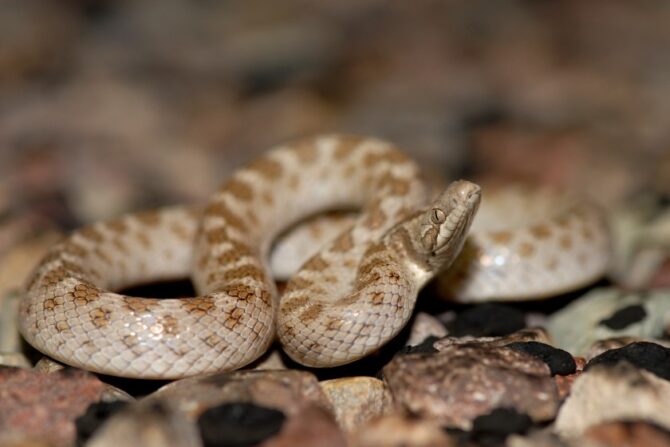
- Scientific Name: Hypsiglena torquata
- Length: 1 – 2.2 ft
- Identifying Features: Light brown, pale gray, or beige, with brown or dark gray blotches on the sides and back.
- Where Found: British Columbia; Western United States, and Guerrero, Mexico
- Conservation Status: Least Concern
The night snake looks similar to a rattlesnake and is characterized by its light brown, pale gray, or beige, with brown or dark gray blotches on the sides and back.
Its head is flat and triangular-shaped, often featuring a pair of visible dark brown blotches on the neck.
Additionally, it has a black or dark brown bar behind the eyes that stands out against the pale gray or white upper labial scales, and it has a vertical pupil.
Its belly is white or yellowish. On average, females tend to be longer and heavier than males.
While the night snake is known to be crepuscular (i.e., active during dusk and dawn), it is also nocturnal.
Although its venom poses no threat to humans, it uses it to subdue its prey.
3. Boa Constrictor
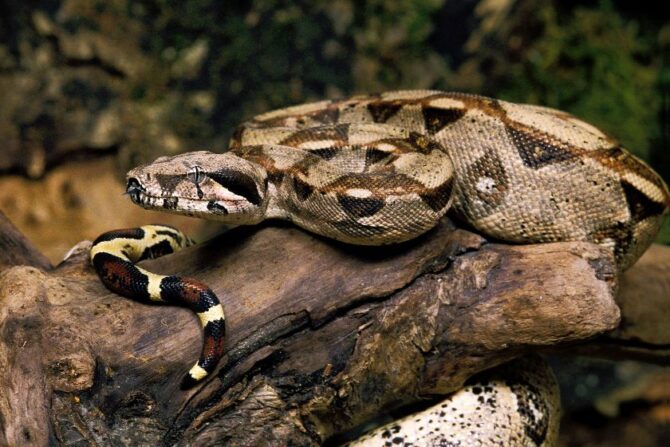
- Scientific Name: Boa constrictor
- Length: 3 to 13 ft
- Weight: 60 pounds
- Identifying Features: Large, patterned, brown, gray, or cream color
- Where Found: South America
- Conservation Status: Least Concern
The boa constrictor is also called the red-tailed boa, and just like the aforementioned ones, it is non-venomous.
That said, it is larger than the ball python and the African house snake. The boa constrictor is often found in South America, though you can see it in zoos around the world.
Many snakes, like the Burmese python, are bigger than the boa constrictor, but one can’t deny that the latter is quite big. Females are larger, and the difference is noticeable.
The boa constrictor hunts at night, using the constricting method of wrapping itself around its prey and choking the prey.
4. Brazilian Rainbow Boa
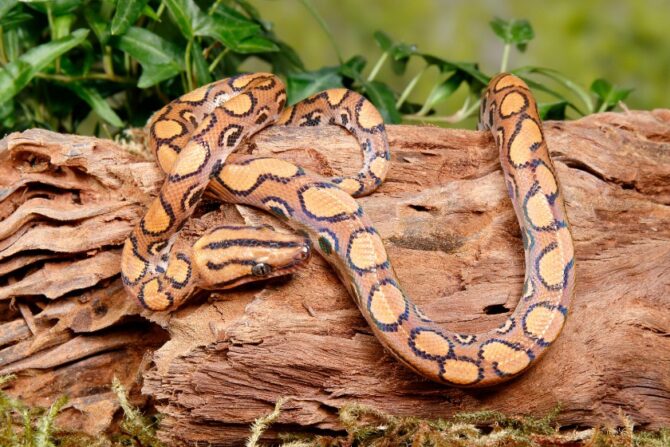
- Scientific Name: Epicrates cenchria
- Length: 4 to 6 feet
- Weight: 2 to 5 pounds
- Identifying Features: Reddish brown, black stripes, iridescent
- Where Found: Central America
- Conservation Status: Least Concern
The Brazilian rainbow boa can be found only in Central and South America, and it boasts five subspecies.
It stays more on land and hunts at night, though some individuals are arboreal. Its habitats consist of rainforests and humid woodlands.
The most noticeable physical trait of the Brazilian rainbow boa is its iridescent color which brought about the name.
A lot of these animals are kept in captivity, and with good care, they can live as long as 30 years.
5. Milk Snake

- Scientific Name: Lampropeltis triangulum
- Length: 14 to 72 inches
- Weight: 1.3 to 7.9 ounces
- Identifying Features: Red, black, and yellow bands
- Where Found: North America
- Conservation Status: Least Concern
The milk snake is a popular pet reptile as it is small, non-venomous, and colorful. There are 24 subspecies currently listed under the milk snake, all of which have peculiar traits.
Some experts have pushed for them to be separate species, but that hasn’t yet been possible.
Some traits common to these subspecies are the smooth, shiny scale and the bands that are commonly red, black, and yellow. The milk snake resembles the poisonous coral snake.
This is a good thing in the wild as it scares away potential predators, but you’d have to be careful to not mix them up if you want to keep the milk snake as a pet. The milk snake is more active at night.
Also See: Milk Snake vs. Corn Snake: Discover the Differences & Similarities
6. Philippine Cobra
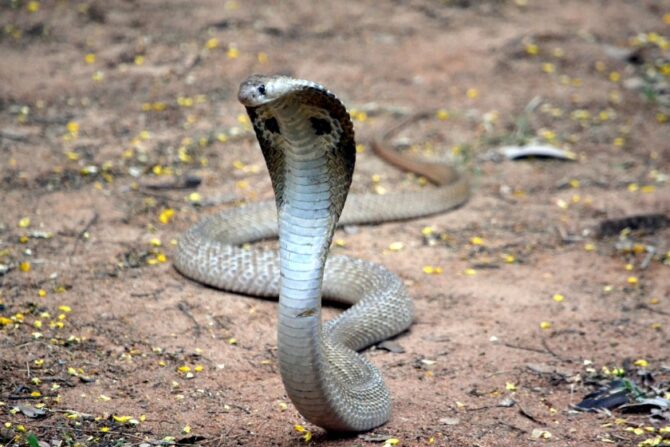
- Scientific Name: Naja Philippiensis
- Length: 3.3 to 5.2 ft
- Weight: 13 pounds
- Identifying Features: Moderate eyes, stocky build, expanding cervical ribs
- Where Found: Philippines
- Conservation Status: Near Threatened
The Philippine cobra is also called the Philippine spitting cobra or the northern Philippine cobra, and as all the names show, it is from the Philippines.
It is the first venomous snake on this list, and its venom is highly toxic.
One obvious trait of the Philippine cobra is the long cervical ribs that expand when it feels threatened.
It also has a head that’s very connected to the neck, moderate eyes, a stocky body, and brown color.
Its preferred habitats include open fields, grasslands, agricultural fields, and dense grasslands.
7. Green Anaconda

- Scientific Name: Eunectes murinus
- Length: 9.3m
- Weight: 66 to 154 pounds
- Identifying Features: Olive-green color, stocky body,
- Where Found: South America
- Conservation Status: Least Concern
The green anaconda goes by other names like the common water boa, the sucuri, the giant Esmerald anaconda, and the common anaconda.
It is one of the longest snake species you’ll find and the heaviest as well. Being a boa species, it is non-venomous.
True to its name, the green anaconda has olive-green skin. Supplementing the green colors are black blotches and orange-yellow stripes on both sides.
Other physical features are eyes at the top of the head that helps it swim.
8. Rosy Boa
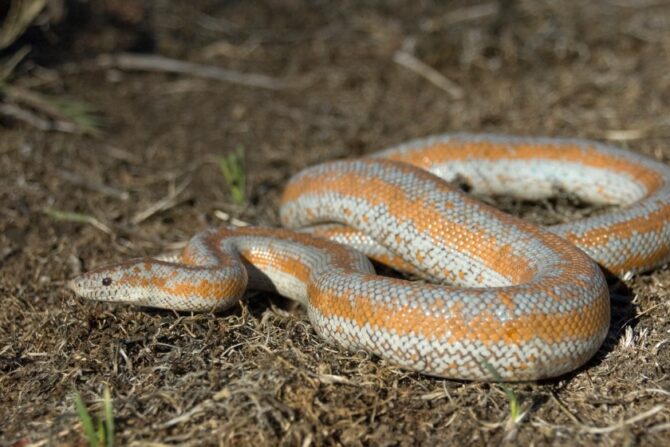
- Scientific Name: Lichanura trivirgata
- Length: 17 to 44 inches
- Weight: 450g
- Identifying Features: Rose belly, thick body, small head
- Where Found: United States
- Conservation Status: Least Concern
The rosy boa goes by the full name of the desert rosy boa, and it is a native of the United States.
It isn’t the only native boa of the United States. You’d also find the coastal rosy boa and the rubber boa.
This snake is small, though the exact length may vary by individual. The colors vary as well and usually depend on the location.
That said, many rosy boas have rose-colored bellies, which leads to its name. The rosy boa inhabits the Sonoran desert.
9. Woma Python

- Scientific Name: Aspidites ramsayi
- Length: 4.5 ft
- Weight: 550g
- Identifying Features: Narrow head, small eyes
- Where Found: Australia
- Conservation Status: Least Concern
The woma python is also called Ramsay’s python or the sand python. It can only be found in Australia, and while it is critically endangered in some regions, overall, it is listed as the least concern.
It often rests in hollow logs or under leaf debris during the day. At night, it becomes more active.
The woma python has a broad body with a color that goes from pale brown to black. Added to this are patterns that can be brown, olive, orange, pink, or red.
10. Western Taipan
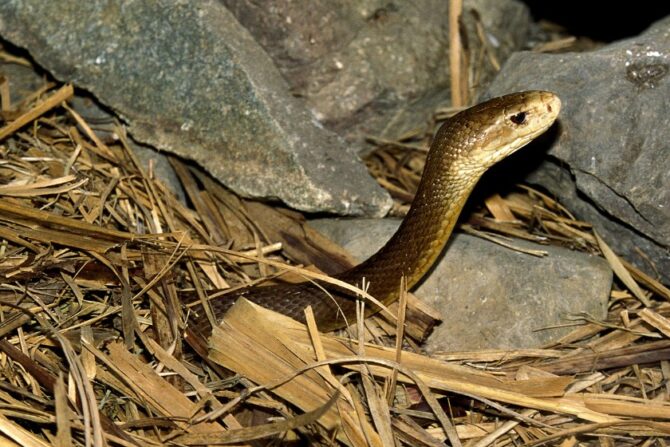
- Scientific Name: Oxyuranus microleptidotus
- Length: 5.9 ft
- Weight: 3 to 4.4 pounds
- Identifying Features: dark tan, brown, grey
- Where Found: Australia
- Conservation Status: Least Concern
The western taipan is also called the inland taipan, a small-scale snake or fierce snake. It can only be found in Australia, and it is one of the few on this list that is venomous.
Its venom is considered highly toxic, far more than any snake. Fortunately, the western taipan is shy and reclusive, reducing the chances of being bitten by it.1
The western taipan is colored tan, though the color can vary based on the season.
This is its way of adapting to seasonal changes. Because of its shy nature, encountering it can be hard.
11. African House Snake
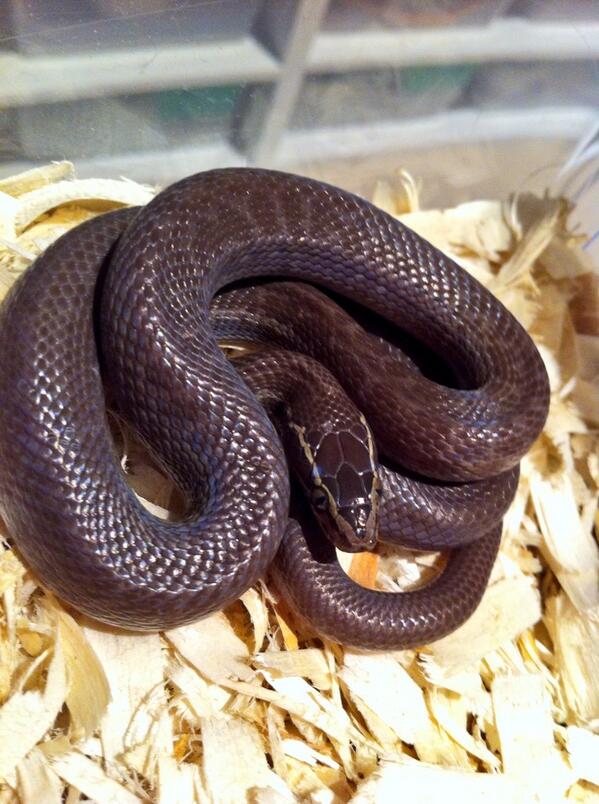
- Scientific Name: Lamprophis
- Length: 30 to 59 inches
- Weight: 150 to 300g
- Identifying Features: Dark brown with many patterns
- Where Found: Africa
- Conservation Status: Not Extinct
The African house snake is the common name for a genus of snake called Lamprophis.
These snakes are usually medium-sized, nonvenomous, and night crawlers. They are often found in Africa, which explains the name.
This snake comes in different patterns. While some have spots, others are striped or may not have any marks on their bodies.
The sexes are widely different, with the females being larger than the males.
The African house snake feeds on rodents, reptiles, and many other small mammals.
Being nonvenomous, these snakes are harmless and would rather flee than bite.
Conclusion
There are a lot more nocturnal snakes than we mentioned here, but these are enough to understand.
Please note that this article is for educational purposes. If you decide to keep one of these animals as a pet, do further research on what it entails.
Do you know any other nocturnal species that we skipped? Let us know in the comment section below.
Next up…
- Does Diesel Keep Snakes Away? (Best Snake Repellents)
- 8 Snakes That Stand Upright (With Pictures & Facts)
References & Notes
- Munson O. What is the most venomous snake in the world? Meet the inland taipan (if you dare). USA Today.


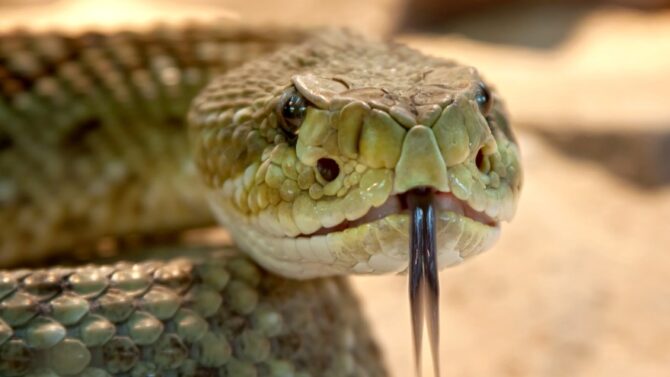
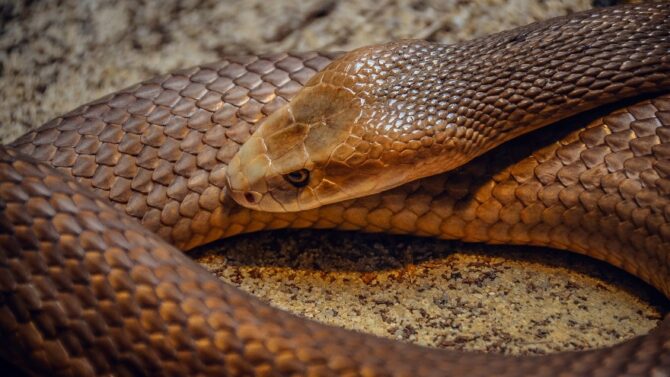
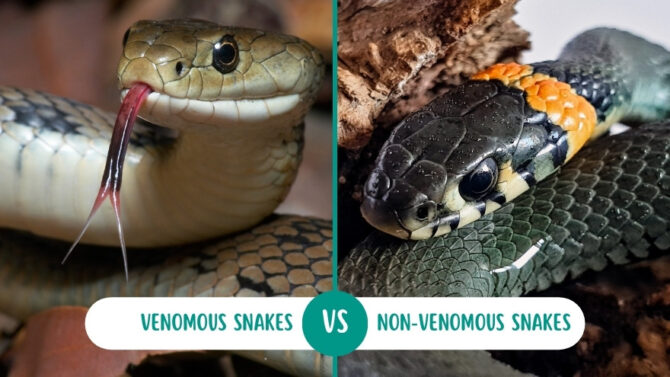

![How Often Do Corn Snakes Shed Their Skin [Answered]](https://animalvivid.com/wp-content/uploads/2022/11/How-Often-Do-Corn-Snakes-Shed-Their-Skin-Answered.jpg.webp)